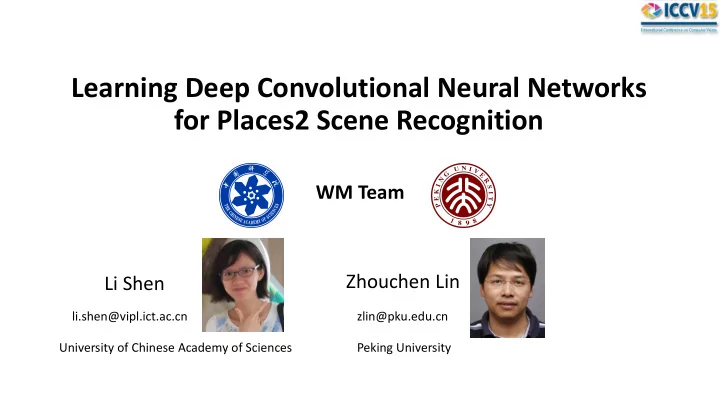

Learning Deep Convolutional Neural Networks for Places2 Scene Recognition WM Team Zhouchen Lin Li Shen li.shen@vipl.ict.ac.cn zlin@pku.edu.cn University of Chinese Academy of Sciences Peking University
Summary of Our Submissions • 1 st place in Places2 Scene Classification Challenge with provided training data
Key Components • Optimization: Relay Back-Propagation • Network Architectures • Class-aware Sampling
Motivation • “Going deeper” is promising to improve the accuracy • Difficulty: The improvement on accuracy cannot be trivially achieved by simply increasing the depth of network.
Why this phenomenon happens? • Gradient vanishing / exploding? Using refined initialization [1] , Batch Normalization [2] etc. has greatly reduced the risk of this issue. [1] Kaiming He, Xiangyu Zhang, Shaoqing Ren and Jian Sun. Delving Deep into Rectifiers: Surpassing Human-Level Performance on ImageNet Classification . In ICCV 2015. [2] Sergey Ioffe and Christian Szegedy. Batch Normalization: Accelerating Deep Network Training by Reducing Internal Covariate Shift . In ICML 2015.
Insight • Although the gradient does not vanish, if we view the BP as an information propagation process, then by information theory, e.g., the Data Processing Theorem, the amount of information still diminishes .
loss1 fc fc BP from loss1 fc loss2 maxpool fc conv fc conv conv maxpool conv conv BP from loss1 & loss2 loss3 maxpool conv fc fc conv conv maxpool conv conv Relay Back-Propagation BP from loss2 & loss3 maxpool conv conv conv conv maxpool BP from loss3 conv conv maxpool conv conv input
Network Architectures Propagation path of loss2 Interim loss2 Propagation path of loss1
Class-aware Sampling • Training data in Places2 dataset large scale : 8 million in total non-uniform class distribution : between 4,000 and 30,000 per class
Class-aware Sampling Class list & 401 class-specific image lists ~0.6% improvement Training batch Class A Class B Class C
Class-aware Sampling Class list & 401 class-specific image lists ~0.6% improvement Training batch Class B Class C Class A
Error Rates (%) on Validation Set Our model ensemble achieves 47.21% top-1 error and 15.74% top-5 error. In the brackets are the improvements over the baseline. × × × N, etc.) Input image size: 256 N × Crop size: 224 224 Single model: multi-view, multi-scale (256 N, 320 [3] Chen-Yu Lee, Saining Xie, Patrick Gallagher, Zhengyou Zhang and Zhuowen Tu. Deeply-Supervised Nets. In Proceedings of AISTATS 2015.
Error Rates (%) on Test Set Our team “WM” won the 1 st place in the Places2 Scene Classification Challenge, and our five submissions won the top five places.
Successfully Classified Examples 1. art studio 1. amusement park 2. art gallery 2. carrousel 3. artists loft 3. amusement arcade 4. art school 4. water park 5. museum 5. temple 1. sushi bar 1. oilrig 2. restaurant kitchen 2. islet 3. delicatessen 3. ocean 4. bakery shop 4. coast 5. pantry 5. beach
Incorrectly Classified Examples 1. hotel room 1. aqueduct 2. bedroom 2. viaduct 3. bedchamber 3. bridge 4. television room 4. arch 5. balcony interior 5. hot spring GT: pub indoor GT: waterfall block 1. lift bridge 1. corridor 2. tower 2. hallway 3. bridge 3. elevator lobby 4. viaduct 4. lobby 5. river 5. reception GT: skyscraper GT: entrance hall
Future Work • Theoretical support for Relay BP • Exploration of Relay BP with other technique (e.g., skip connections) Details and more experimental evaluation will be described in our arXiv paper.
Recommend
More recommend